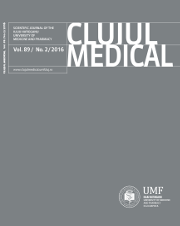Fecal transplantation indications in ulcerative colitis. Preliminary study
DOI:
https://doi.org/10.15386/cjmed-613Keywords:
ulcerative colitis, fecal transplantation, clostridium difficile, biological therapyAbstract
Background and aims. Fecal microbiota transplantation is used with success in persistent (more than two episodes) Clostridium Difficile Infection; it has also gained importance and started to be used in inflammatory bowel disease. There are theoretical arguments that justify its use in ulcerative colitis or Crohn’s disease. Based on our clinical cases we tried to evaluate the indications of fecal microbiota transplantation young patients with ulcerative colitis and multiple relapses, in which biological or immunosuppressive treatment were ineffective.
Methods. Five patients with moderate-severe ulcerative colitis or Clostridium Difficile infection who ceased to have a therapeutic response to biological therapy, were given fecal microbiota transplant as an alternative to biological therapy and/or immunosuppression. Fecal microbiota transplant was administered via colonoscopy using healthy donors from their family.
Results. The results were favorable and spectacular in all patients and complete remission was achieved for at least 10 months. Clinical remission was achieved in all patients. Endoscopic appearance of ulcers in patients improved. In 2 patients the effect of the fecal microbiota transplant diminished after 10-12 months and the tendency to relapse appeared (3-4 stools/day, blood streaks present sometimes in the stool). Reintroduction of systemic therapy or immunosuppression demonstrated that patients regained the therapeutic response to these treatments, and remission was maintained.
Conclusion. Fecal microbiota transplantation can be used as salvage therapy in patients refractory to biological therapy, as elective therapy in clostridium difficile infection or as an alternative therapy in young patients with multiple relapses who have reservations regarding biological or immunosuppressive treatment.
Downloads
Additional Files
Published
How to Cite
Issue
Section
License
The authors are required to transfer the copyright of the published paper to the journal. This is done by agreeing to sign the Copyright Assignment Form. Whenever the case, authors are also required to send permissions to reproduce material (such as illustrations) from the copyright holder.

The papers published in the journal are licensed under a Creative Commons Attribution-NonCommercial-NoDerivatives 4.0 International License.

